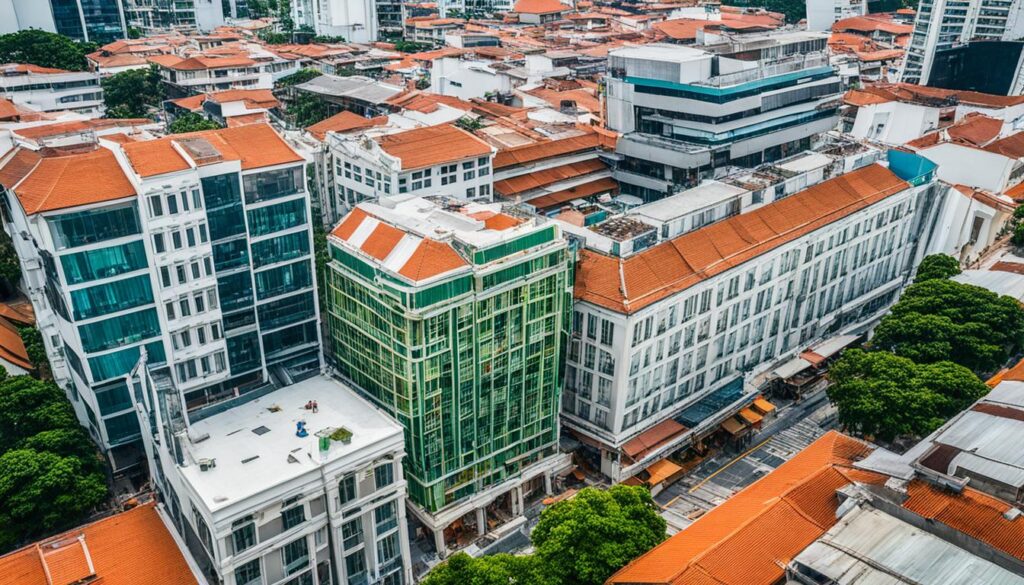
As the dawn of 2024 illuminates the familiar skyline of Singapore, the real estate market whispers a new narrative—where bricks and mortar reflect much more than mere structures; they embody the resilience and adaptability of a nation that has weathered storms and is now surfacing from economic trials. For Singaporeans, their homes are more than a haven—they are a testament to dreams and the future they aspire towards. It’s within this context that we explore the singapore property outlook, an ever-evolving tapestry woven with the vitality of housing market trends in singapore, poised at the cusp of change. With the pulsating heart of city life slowly recalibrating in the post-COVID-19 epoch, we delve into the rich complexity of the real estate market singapore has to offer.
The landscape is changing: high occupancy caps signal a new era for landlords and tenants alike, while the mortgage scene undulates with the tide of federal rate cuts, potentially redefining the meaning of home ownership. Mixed-use properties emerge as the dark horses in the race, promising opportunities hidden in the contours of the Core Central Region. In the midst of this transition, approximately 11,000 new units usher in, alongside 38 predicted launches, orbited by the eternal allure of proximity to the MRT stations amidst skyrocketing car ownership costs. What’s undeniable is that the real estate narrative of Singapore, heading into 2024, is one of resilience and reinvention, beckoning a new chapter for buyers, sellers, and investors.
Key Takeaways
- Observing the singapore property outlook reveals shifts towards higher occupancy, impacting landlords and tenants.
- Emerging housing market trends in singapore include a movement away from fixed-interest home loans due to expected rate adjustments.
- Mixed-use properties in the Core Central Region are drawing increasing interest from buyers seeking value.
- The new housing supply is set to stabilize with a significant number of launches, shaking up the real estate market singapore.
- Connectivity to MRT stations remains a pivotal factor driving property demand.
- Renters and investors need to adapt to a changing market dynamic with new strategies.
The Dynamic Rise in Occupancy Caps: Implications for Landlords and Tenants
In the evolving landscape of the Singapore property market, a significant policy shift increasing the occupancy caps from six to eight unrelated tenants in 4-room or larger flats and private properties over 90 square meters is reshaping rental dynamics. This development stands at the crossroads of Singapore property market trends and property investment trends in Singapore, signaling transformative implications for stakeholders.

- Rental Yield Enhancement: With higher occupancy rates now permissible, landlords may anticipate improved rental yields, standing to gain greater income from their investments provided they can capitalize on the full occupancy allowance.
- Affordability for Tenants: The policy adjustment offers tenants the prospect of more affordable living arrangements, as the cost of rent can be distributed across a greater number of occupants.
However, the transition is not without its intricacies:
- Tenants’ Bargaining Power: Amidst a softening rental market characterized by decreased rates, tenants might find themselves in a favorable position to negotiate the terms of leases, making the most out of expected tenant-landlord discussions.
- Market Recalibration: Landlords must navigate a rental landscape undergoing recalibration due to the confluence of increased housing supplies and tenant bargaining strength, potentially leading to a reset in rental income expectations.
As Singapore’s property investment trends take new shape, the industry watches closely how these regulatory changes will impact the larger narrative of the Singapore property market trends, shaping the future of real estate investment and tenancy.
Rethinking Loan Strategies: The Shift Away From Fixed-Interest Home Loans
Anticipated changes in the fiscal approach of the Federal Reserve, with a possibility of interest rate cuts, are setting the stage for a transformation within the Singapore property market. Homebuyers and investors are now weighing the implications of these global monetary shifts on their long-term borrowing strategies.
Impact of Potential Interest Rates Cuts
The property market analysis in Singapore is closely monitoring the signaling of likely interest rate reductions by key financial institutions. As rate cuts are on the horizon, a ripple effect is expected to alter the appeal of fixed-interest home loans. Borrowers may find floating rate loans more attractive, given their direct correlation with interest rate trends.
- Review of existing fixed-rate home loan commitments by property owners.
- Preparations for refinancing options as the market adjusts to rate cuts.
- Potential savings and reduced borrowing costs for new and existing homeowners.

Adjustments Amidst Changing Home Loan Interest Rates
Adjusting to the new landscape, both new and seasoned investors will likely recalibrate their loan portfolios. Rate fluctuations influence not only the cost of borrowing but also define the strategic positioning in the larger context of singapore property market trends.
- Migration from fixed-interest to floating-rate loans among borrowers.
- Adaptation to the altered risk assessment by financial institutions.
- Enhanced analysis and revised investment strategies in the property sector.
The shifting economic winds necessitate a proactive reassessment of financial strategies, ensuring that Singapore’s property market participants remain informed and agile in a changing fiscal landscape.
Singapore Property Market Trends: A Shift in Demand

Amidst a dynamic economic environment, the singapore property outlook is currently undergoing substantial changes, reflecting a trend towards more advantageous conditions for buyers. The real estate market singapore is adjusting to these shifts as indicated by several compelling developments:
- Increasing buyer demand for mixed-use properties, indicative of a growing preference for versatile living and investment spaces.
- Introduction and rapid adoption of high-tech condo developments that cater to the modern demands of convenience, connectivity, and sustainability.
- A marked adjustment in property prices, making them more attuned to market conditions and buyer expectations, fostering favorable investment climates.
This pivot towards buyer-aligned offerings is most evident when examining the patterns of transaction activities among Employment Pass holders, whose modest growth has served as an integral measure for economic vitality. Evidently, transactions taking place within this sector have illuminated the intricate relationship between domiciliary supply, pricing structures, and strategic investment decisions—each being a focal point for stakeholders within the market.
- Assessment of market sensitivity in project pricing strategies, ensuring alignment with consumer expectations and financial feasibility.
- Strategic development of properties that harmonize luxury with technological advancements, meeting the sophisticated needs of both local and expat buyers.
- Monitoring of long-term trends in the contribution of foreign talents, such as EP holders, to the forecasted stabilization in the property market.
Together, these points of consideration are vital for understanding the nuanced shifts in Singapore’s property landscape and for anticipating future developments that may redefine investment and ownership strategies in these unprecedented times.
The Resurgence of Interest in Ageing Mixed-Use Properties
The real estate market in Singapore is witnessing a remarkable revival of interest in ageing mixed-use developments, with iconic projects like the Golden Mile Complex leading the charge. This uptick in popularity signals a significant shift in the dynamics of the singapore property market trends, as developers and investors alike begin to recognize the latent potential of these prime yet underutilized spaces.

Amid the real estate market singapore, the presence of such developments beckons a wealth of opportunities, underpinned by the promise of strategic redevelopments. Here, the motives and outcomes driving the transformations are multifaceted, offering a glimpse into the future of urban architectural heritage.
Redefining Golden Mile Complex and Similar Developments
The Golden Mile Complex, along with other ageing structures, is undergoing a process of redefinition. Where some see an outdated building, visionaries envisage a canvas for modern innovation, blending the old with the new. The emphasis on maintaining the architectural essence while infusing current amenities appeals to a broad spectrum of potential tenants, from businesses to residents seeking a unique lifestyle experience.
Opportunities Arising from Redevelopment
- Increase in Property Value: Redeveloped mixed-use properties often experience a surge in value, attributed to modern features and desirability among contemporary businesses and homebuyers.
- Cultural Preservation: There is a movement towards integrating cultural preservation with urban development, thus protecting the architectural identity and history of Singapore’s landscape.
- Sustainable Investment: Through thoughtful redevelopment, ageing properties can become beacons of sustainability, aligning with global and national goals for a greener urban footprint.
The optimism driving this resurgence remains cautiously tempered by considerations such as ABSD rates and the potential oversupply in the Core Central Region (CCR). Nevertheless, the current trends point towards a real estate landscape ripe for revitalization, where the old is not displaced but rather reimagined to suit the evolving needs of Singapore’s cosmopolitan society.
Property Investment Trends Singapore: The Search for Value in the CCR
The luxury real estate sector within Singapore’s Core Central Region (CCR) is currently at the epicenter of a significant shift in property investment trends. Investors are becoming increasingly meticulous in their search for value amid a dynamic landscape shaped by elevated Additional Buyer’s Stamp Duty (ABSD) rates and a burgeoning inventory of high-end units. This environment has led to a softened demand, presenting an attractive terrain for those equipped with the acumen to discern true value from a plethora of options available in the market.
Housing market trends in Singapore suggest a nuanced approach is required for investors eyeing the prime districts of the CCR. The complex interplay of economic factors, including potential interest rate increments, could complicate luxury property investments. Despite these challenges, analytical investors may identify a silver lining as these market pressures provide a fertile ground for value purchases. With an attentive gaze on market dynamics, select properties in prestigious areas like Orchard, Newton, and Marina Bay could yield substantial potential for both short-term gains and long-term appreciation.
In conclusion, the Singapore property market’s latest pulse indicates that the CCR is ripe for calculated, value-driven investments. The interwoven effects of regulatory changes and market forces demand a strategic approach to capital deployment. As seasoned buyers navigate these turning tides, opportunities to capitalize on what may be undervalued assets are emerging, tasking investors with the challenge to harness these housing market trends in Singapore to their advantage. Proactive engagement with the current real estate landscape is essential for those looking to secure their place in one of Asia’s most vibrant property markets.

